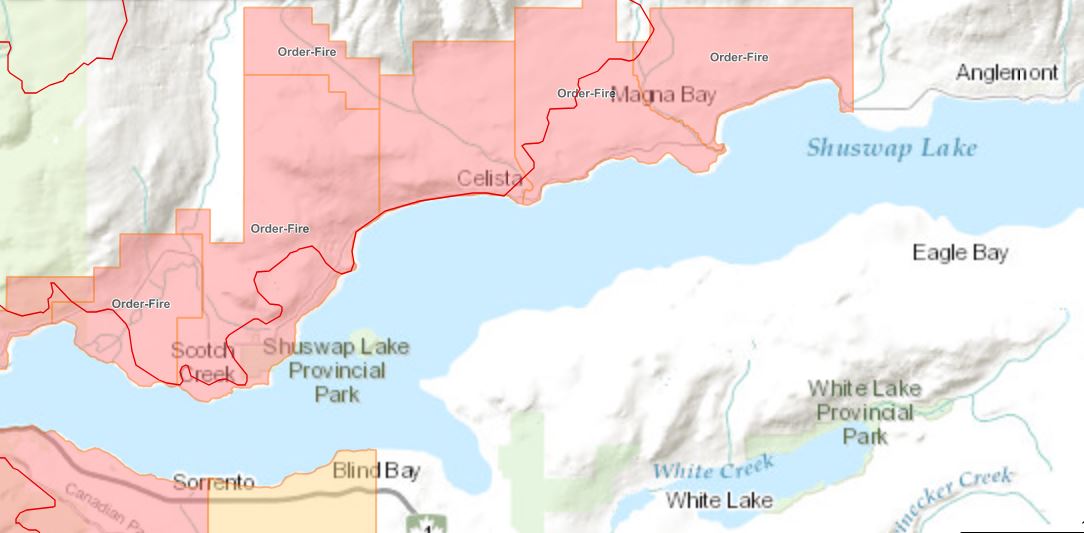People living in a part of B.C.’s North Shuswap ravaged by a massive wildfire launched a boat convoy Monday to supply residents of communities cut off by the flames.

But the supply efforts hit choppy waters, amid concerns from officials that the initiative may not be safe.
Locals gathered in Blind Bay Monday morning, on the south shore of Shuswap Lake’s Shuswap arm.
The plan was to load donated supplies from a Sysco Foods semi-trailer and ferry them to Anglemont on the north side of the lake, near the communities of Lee Creek, Scotch Creek and Celista which were devastated by the 41,000-hectare Bush Creek East fire.
That plan ran into trouble when authorities stopped the truck in Salmon Arm, and told residents that taking their boats on the lake could hamper efforts to fight the fire from the air.
At a Monday briefing, Emergency Management and Climate Readiness Minister Bowinn Ma urged people to stay away from the fire-affected areas.

“This isn’t a suggestion. It is the law,” Ma said.
“You may think that you are helping yourself or your neighbours by staying behind or supporting individuals who are staying behind with food or supply runs, but you are not. You’re making a highly dangerous situation even more dangerous for everyone involved.”
Eventually, convoy organizers got word that firefighting aircraft had been grounded due to heavy smoke in the area.
Despite the truck not getting through, locals worked to load a variety of supplies including generators, fuel and water into their boats.
“I don’t care if we’ve got to paddle over in a raft, we’ll go help these people. They need help,” Alan MacDonald told Global News.
“We’ve been here for 18 years, we know the lake, we know how to boat, we’re not stupid, just let us load up our stuff and get it across and help these poor people.”
Many of the boats stuck to the lake’s south shore, avoiding the fire evacuation zone, crossing the lake and docking in Anglemont.

Organizer Mark Taggart explained said locals were frustrated their efforts were being blocked, given they were steering clear of any evacuation orders or alerts.
“This is my community, we live in Anglemont, these are all our friends, extended family, and we’re just trying to help these first responders that feel abandoned,” he explained.
“That’s what the government is not understanding, the (Columbia Shuswap Regional District) and the local governments, they don’t understand that people feel abandoned and they’re just trying to save their houses.”
Bill Long, who has been ferrying people across the lake with his boat, said residents on the ground were instrumental in putting out spot fires and saving homes.
He said he wanted to see official agencies making use of the community’s resources and local knowledge.
“Better communication. Don’t stop what’s going on. Encourage the neighbourhoods to come together as they have — and coordinate it,” he said.
“There are no resources over there … they can’t fly because of the smoke. My advice is be part of the solution, not part of the problem. Right now they are part of the problem.”

The regional district issued its own statement Monday, also urging people to stay out of the fire zone.
“The Columbia Shuswap Regional District (CSRD) understands that many residents want to remain in the Evacuation Order area to protect their properties. We must stress that this decision puts both you and our tireless responders at high risk,” it said.
The district also again raised concerns about people taking or moving equipment deployed in the fire zone, including pumps, sprinklers, hoses and all-terrain vehicles, “critically impacting the effectiveness of structural protection.”
“Interfering with BC Wildfire crews not only endangers your safety but also hinders their vital work,” it said.
“Please be aware that if their operations are disrupted, they may have no choice but to relocate to a safer area.”
As of Monday, there were 53 firefighters and 49 support staff assigned to the fire, along with 105 structure protection personnel, 62 pieces of heavy equipment and 17 helicopters.
The BC Wildfire Service said the region was expecting winds of 20 km/h influenced by Tropical Storm Hilary, with gusts of up to 40 km/h.
It added that there is ongoing potential for extreme fire behaviour, but that smoke cover was helping reduce fire activity and that there was the potential for two-to-three millimetres of rain which could help firefighting efforts.
- BC Conservation Officer Service says orphaned bear in Bralorne is too old to rehabilitate
- Gas prices in Metro Vancouver drop 6 cents overnight, more savings Friday
- Quesnel city council censures mayor over controversial residential school book
- Surrey hospital won’t have emergency team for parts of May long weekend, doctor claims







Comments